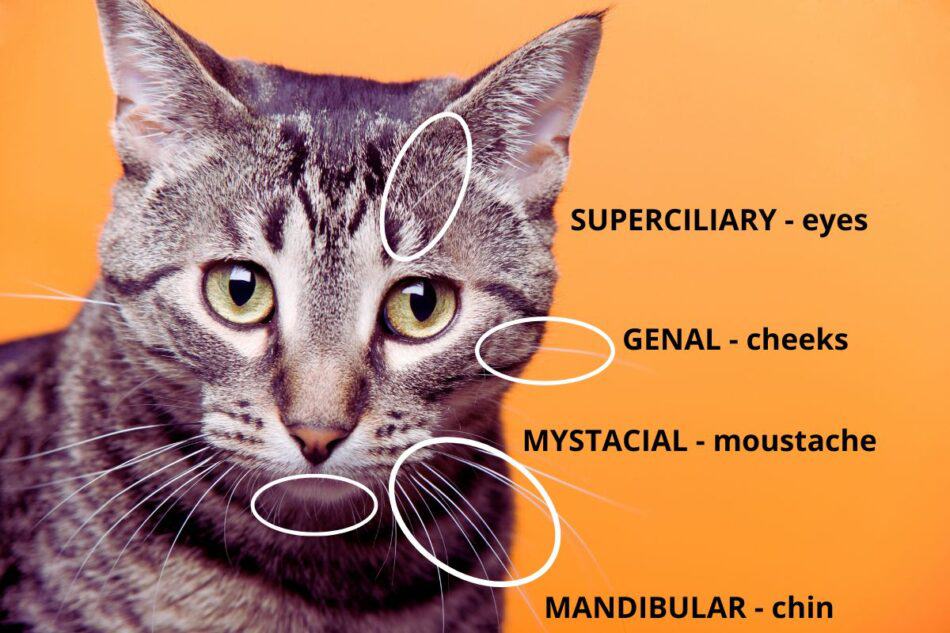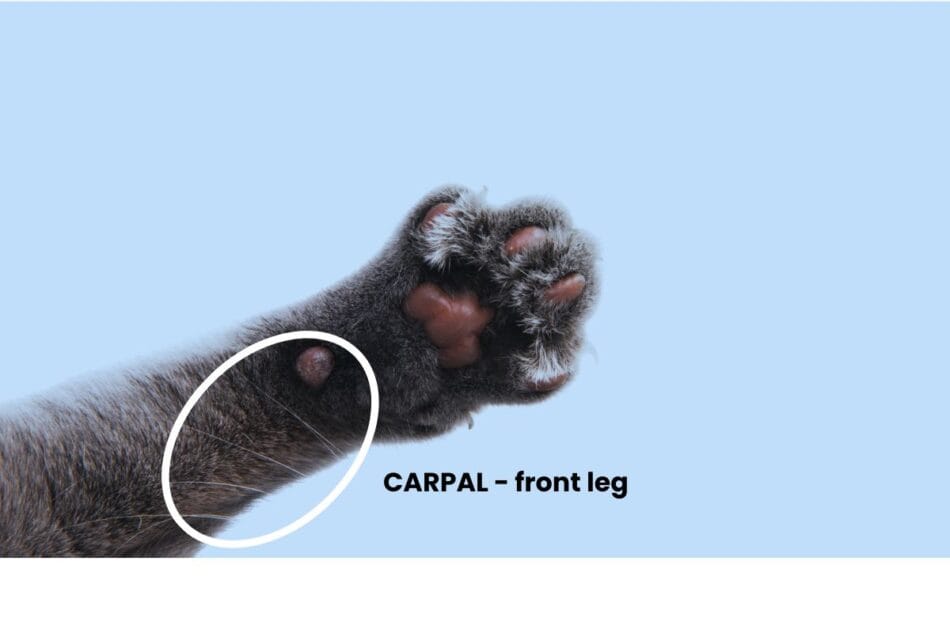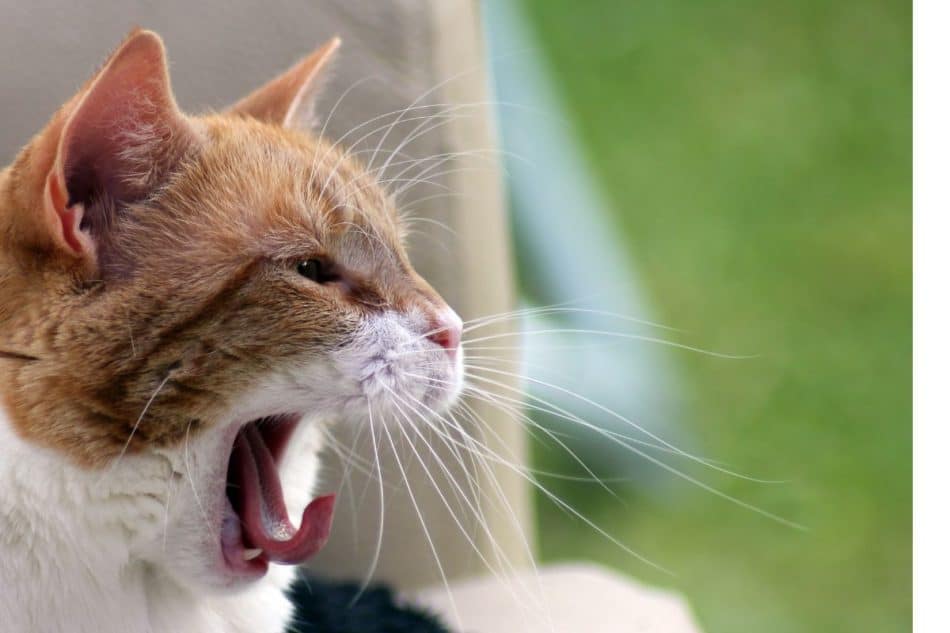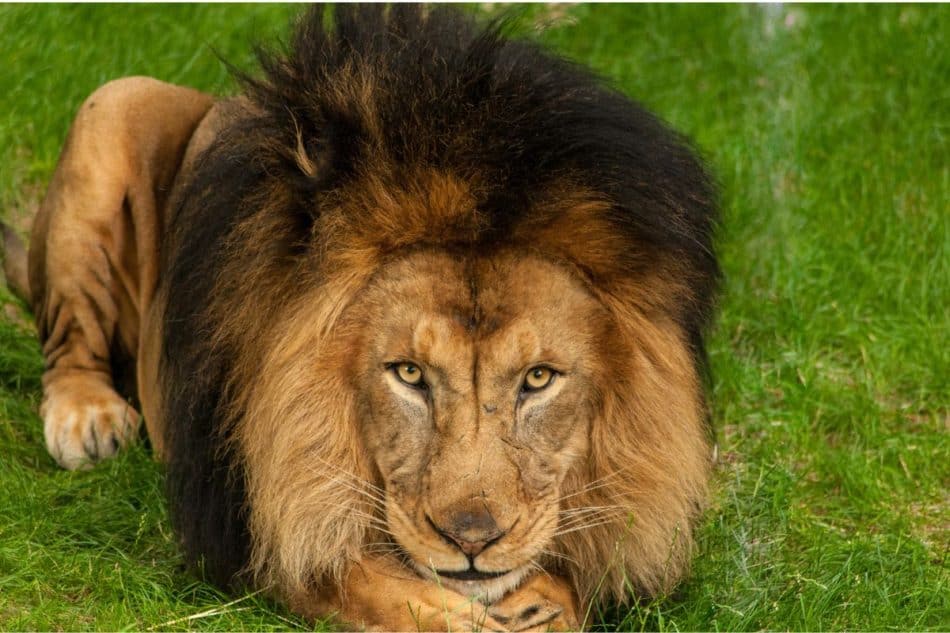Table of Contents
Introduction
Cats use their whiskers to inform them about things they are interacting with, whether that be prey or a narrow passage or tall grass or a bowl of cat food.
Cats have whiskers on four locations on their face, and they also have whiskers on their front legs.
What Are a Cat’s Face Whiskers Called?
Superciliary whiskers are located just above the eyes. It is thought that if something touches those whiskers, the cat will blink so as to protect their eyes.
Genal whiskers are on the cheeks and probably act along with the mystacial whiskers to help the cat know what is near the cat’s face.
Mystacial whiskers are located where a moustache would be, and they provide the cat with information about what is being encountered.
Mandibular whiskers are found on the chin, and may assist the cat in knowing more about any prey the cat is trying to subdue or any food or water the cat is contemplating consuming.

What Are a Cat’s Leg Whiskers Called?
Carpal whiskers are located on the back of a cat’s front legs just above the paw and may inform the cat about grass and foliage the cat is walking through or what the cat is grasping with their paws.

How do Cat Whiskers Help the Cat?
As described in my blog post Why Does My Cat Blink At Me, cats have poor up-close vision. They do not focus well on objects closer than about one foot in front of their face.
To compensate for this close-up vision problem, cats have been given an additional tool…..their whiskers.
According to the Neuroethology Blog of the New College of Florida: “….In cats, whiskers supplement close range vision by perceiving vibrations and motions around them. ….”
According to an article in The Magazine of the California Academy of Sciences, when the whisker is moved, whether by an object or the movement of air, this stimulates nerves in the whisker follicle that in turn send a signal to the cat’s brain.
According to an article on the website Scholarpedia, the nerves in whisker follicles have a connection to a region of the brain that processes sensory information.
Further, a paper published in the National Library of Medicine says that this whisker-brain connection “…..allows high accuracy discriminations of object distance, direction, and surface texture”.
In other words, a cat’s whiskers provide the animal with a wealth of knowledge about the environment the cat occupies.
Are Cat Whiskers the Same as Cat Hair?
Whiskers are indeed hairs, but whisker hairs are different in form and function from human hairs, and from the hairs that make up a cat’s fur coat.
Whisker hairs are also called tactile hairs, the word tactile indicating reference to the sense of touch.
The scientific community refers to whisker hairs as vibrissae, a word derived from the Latin word vibrare, meaning “to vibrate”.
The hairs that constitute the fur of a mammal are referred to as pelagic hairs, and these hairs are not as thick as vibrissae hairs..
Cat whiskers grow out of a cavity in the skin known as a follicle, but there are differences between a pelagic hair follicle and a vibrissae whisker follicle. The vibrissae follicles have the sensory apparatus as described in the previous section.
What Are Cat Whiskers Made Of?
Animal whisker hairs and animal fur hairs and human hairs all have as the primary structural component a protein called keratin, which is also a primary component of fingernails, claws, and horns.
Do Cats Shed Whiskers?
Cats will occasionally shed a whisker and a new whisker will grow in its place. This is a normal thing, but if your cat is shedding whiskers frequently and/or shedding a lot of whiskers, you should consult your vet.
More often than their whiskers, cats often shed fur hair. My blog post How to Deal With Cat Hair will help you keep this necessary part of life with cats under control.
Can Cats Move Their Whiskers?
An article published on the New College of Florida website indicates that small muscles located near the cat’s whisker follicles enable the cat to move the facial whiskers.
I have seen a video that was recorded utilizing an ultra-high speed camera that captured a cat projecting the mystacial whiskers forward while playing with a toy mouse being dangled on a cord.
The reason a high-speed camera was used is that the cat’s whisker movement was really fast. The video was then played in slow-motion so we humans could see it. It does appear in the video that the cat is using those whiskers to help it locate and grab the toy mouse.
If you want to buy a few cat toys to see if your cat’s whiskers move, How to Choose Cat Toys is my blog post that will give you some ideas about what toys your kitty might like.
So yes, cats can move their whiskers, as demonstrated by this kitty moving those facial whiskers forward.

Are Cat Whiskers For Balance?
Cat whiskers are for providing a cat with information, but not for balance.
According to an article published by the Cornell University College of Veterinary Medicine, a cat’s ability to balance is provided by what is called the vestibular system.
Visit my blog post How Do Cats Land on Their Feet for more about how cats maintain balance.
Is It Okay to Trim a Cat’s Whiskers?
It is not okay to trim a cat’s whiskers, and an important reason for this is that the cat’s whiskers are tapered, with the circumference at the base of the whisker being greater than at the tip. and it is believed by the researchers cited below that this taper positively effects the efficiency of the whiskers in doing the job of providing information to the cat.
According to an article published in the scientific journal PLOS NOW a study by academic researchers at Bard College at Simon’s Rock, suggests that tapered whiskers do a better job of sensing what the whisker is touching. To trim a cat’s whiskers could hypothetically remove the advantage of a tapered whisker.
While it is true that the tips of whiskers do occasionally break off, and entire whiskers do sometimes shed, this typically happens one whisker at a time, leaving the other whiskers in place to function as they should.
Do Whiskers Measure Whether a Cat Can Fit Through a Space?
I have heard it said that a cat’s whiskers are precisely as wide as their body, and that the cat uses those whiskers to decide if they can squeeze through a narrow space.
As far as the body width equals whisker width idea goes, I would ask, what happens if the cat gains or loses weight? I have heard this story for years, but I can find no academic research to confirm this, and I simply do not believe there is any validity to it.
Regarding the “can or can’t I fit through there” hypothesis, I will certainly acknowledge that if the opening is not as wide as the whiskers, the cat will sense this and be informed that the opening is narrow. That does not mean the cat cannot just ignore the information and proceed anyway.
Do you think the lion in this photo would rely on his whiskers to tell him the opening is too narrow?

More Information is Available to You
Learn About Cats is one of my blog posts which will give you information on a variety of subjects related to cats. You are invited to visit.
